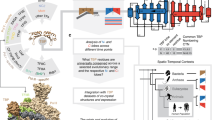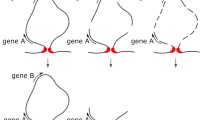Abstract
HMG boxes were initially identified as DNA-binding domains of the human RNA polymerase I (pol I) transcription factor hUBF and the animal high-mobility-group (HMG) protein family HMG1. Since then, numerous sequences of HMG-box-containing HMG proteins and other DNA-binding proteins from several species have become available. By sequence comparisons of a selected range of HMG boxes from these proteins and the construction of phylogenetic trees we show that the HMG box is highly conserved between DNA-binding proteins of organisms from all three eukaryotic kingdoms and that HMG boxes are linked by distinct evolutionary relationships. In addition, most HMG boxes display comparable hydropathy profiles and amino acid arrangements, which could serve as nuclear targeting sequences.
Similar content being viewed by others
References
Alexander-Bridges M, Ercolani L, Kong XF, Nasrin N (1992) Identification of a core motif that is recognized by three members of the HMG class of transcriptional regulators: IRE-ABP, SRY and TCF-1α. J Cell Biochem 48:129–135
Berta P, Hawkins JR, Sinclair AH, Taylor A, Griffiths BL, Goodfellow PN, Fellous M (1990) Genetic evidence equating SRY and the testis-determining factor. Nature 348:448–450
Bianchi ME, Falciola L, Ferrari S, Lilley DMJ (1992) The DNA-binding site of HMG1 protein is composed of two similar segments (HMG boxes), both of which have counterparts in other eukaryotic regulatory proteins. EMBO J 11:1055–1063
Bruhn SL, Pil PM, Essigmann JM, Housman DE, Lippard S (1992) Isolation and characterization of human cDNA clones encoding a high mobility group box protein that recognizes structural distortions to DNA caused by binding of the anticancer agent cisplatin. Proc Natl Acad Sci USA 89:2307–2311
Churchill MEA, Travers AA (1991) Protein motifs that recognize structural features of DNA. Trends Biochem Sci 16:92–97
Dalrymple BP, Peters JM (1992) Characterization of a cDNA clone from the haemoparasiteBabesia bovis encoding a protein containing an “HMG box.” Biochem Biophys Res Commun 184:31–35
Diffley JFX, Stillman B (1991) A close relative of the nuclear, chromosomal high-mobility group protein HMG1 in yeast mitochondria. Proc Natl Acad Sci USA 88:7864–7868
Dingwall C, Laskey RA (1991) Nuclear targeting sequences—a consensus? Trends Biochem Sci 16:478–481
Felsenstein J (1989) PHYLIP—Phylogeny Inference Package (Version 3.2). Cladistics 5:164–166
Giese K, Amsterdam A, Grosschedl R (1991) DNA-binding properties of the HMG domain of the lymphoid-specific transcriptional regulator LEF-1. Genes Dev 5:2567–2578
Grasser KD, Feix G (1991) Isolation and characterization of maize cDNAs encoding a high mobility group protein displaying a HMG box. Nucleic Acids Res 19:2573–2577
Gubbay J, Collignon J, Koopman P, Capel B, Economou A, Münsterberg A, Vivian N, Goodfellow P, Lowell-Badge R (1990) A gene mapping to the sex-determining region of the mouse Y chromosome is a member of a novel family of embryonically expressed genes. Nature 346:245–250
Haass MM, Feix G (1992) Two different cDNAs encoding TFIID proteins of maize. FEBS Lett 301:294–298
Jantzen H-M, Admon A, Bell SP, Tijan R (1990) Nucleolar transcription factor hUBF contains a DNA-binding motif with homology to HMG proteins. Nature 344:830–836
Kaplan DJ, Duncan CH (1988) Full length cDNA sequence for bovine high mobility group 1 (HMG1) protein. Nucleic Acids Res 16:10375
Kelly M, Burke J, Smith M, Klar A, Beach D (1988) Four mating-type genes control sexual differentiation in the fission yeast. EMBO J 7:1537–1547
Kolodrubetz D (1990) Consensus sequence for HMG1-like DNA-binding domains. Nucleic Acids Res 18:5565
Kolodrubetz D, Burgum A (1990) Duplicated NHP6 genes ofSaccharomyces cerevisiae encode proteins homologous to bovine high mobility group protein 1. J Biol Chem 265:3234–3239
Kyte J, Doolittle RF (1982) A simple method for displaying the hydropathic character of a protein. J Mol Biol 157:105–132
Laux T, Goldberg RB (1991) A plant DNA-binding protein shares highly conserved sequence motifs with HMG box proteins. Nucleic Acids Res 19:4769
Lee K-LD, Pentecost BT, D'Anna JA, Tobey RA, Gurley LR, Dixon GH (1987) Characterization of cDNA sequences corresponding to three distinct HMG-1 mRNA species in line CHO Chinese hamster cells and cell cycle expression of the HMG-1 gene. Nucleic Acids Res 15:5051–5068
McStay B, Frazier MW, Reeder RH (1991) xUBF contains a novel dimerization domain essential for RNA polymerase I transcription. Genes Dev 5:1957–1968
Nasrin N, Buggs C, Kong XF, Carnazza J, Goebl M, Alexander-Bridges M (1991) DNA-binding properties of the product of the testis-determining gene and a related protein. Nature 354:317–320
Paonessa G, Frank R, Cortese R (1987) Nucleotide sequence of rat liver HMG1 cDNA. Nucleic Acids Res 15:9077
Parisi MA, Clayton DA (1991) Similarity of human mitochondrial transcription factor 1 to high mobility group proteins. Science 252:965–969
Pearson W, Lipman D (1988) Improved tools for biological sequence comparison. Proc Natl Acad Sci USA 85:2444–2448
Pentecost BT, Wrigt JM, Dixon GH (1985) Isolation and sequence of cDNA clones coding for a member of the family of high mobility group proteins (HMG-T) in trout and analysis of HMG-T-mRNAs in trout tissues. Nucleic Acids Res 13:4871–4888
Reeves R, Nissen MS (1990) The A.T-DNA-binding domain of mammalian high mobility group I chromosomal proteins. J Biol Chem 265:8573–8582
Schulman IG, Wang T, Wu M, Bowen J, Cook RG, Gorovsky MA, Allis CD (1991) Macronuclei and micronuclei inTetrahymena thermophila contain high-mobility-group-like chromosomal proteins containing a highly conserved elevenamio-acid putative DNA-binding sequence. Mol Cell Biol 11:166–174
Shirakata M, Hüppi K, Usuda S, Okazaki K, Yoshida KI, Sakano H (1991) HMG1-related DNA-binding protein isolated with V-(D)-J recombination signal probes. Mol Cell Biol 11:4528–4536
Shirakawa H, Tsuda K, Yoshida M (1990) Primary structure of nonhistone chromosomal protein HMG2 revealed by the nucleotide sequence. Biochemistry 29:4419–4423
Sinclair AH, Berta P, Palmer MS, Hawkins JR, Griffiths BL, Smith MJ, Foster JW, Frischauf A-M, Lovell-Badge R, Goodfellow PN (1990) A gene from the human sexdetermining region encodes a protein with homology to a conserved DNA-binding motif. Nature 346:240–244
Staben C, Yanofsky C (1990)Neurospora crassa a mating type region. Proc Natl Acad Sci USA 87:4917–4921
Travis A, Amsterdam A, Belanger C, Grosschedl R (1991) LEF-1, a gene encoding a lymphoid-specific protein with an HMG domain, regulates T-cell receptor α enhancer function. Genes Dev 5:880–894
Tsuda K, Kikuchi M, Kazuyuki M, Mori K, Waga S, Yoshida M (1988) Primary structure of non-histone protein HMG1 revealed by the nucleotide sequence. Biochemistry 27:6159–6163
van de Wetering M, Oosterwegel M, Dooijes D, Clevers H (1991) Identification and cloning of TCF-1, a T lymphocyte-specific transcription factor containing a sequence-specific HMG box. EMBO J 10:123–132
Wagner CR, Hamana K, Elgin S (1992) A high-mobility-group protein and its cDNA fromDrosophila melanogaster. Mol Cell Biol 12:1915–1923
Waterman ML, Fischer W, Jones K (1991) A thymus-specific member of the HMG protein family regulates the human T cell receptor Cα enhancer. Genes Dev 5:656–669
Wen L, Huang J-K, Johnson BH, Reeck GR (1989) A human placental cDNA clone that encodes nonhistone chromosomal protein HMG-1. Nucleic Acids Res 17:1197–1214
Author information
Authors and Affiliations
Rights and permissions
About this article
Cite this article
Griess, E.A., Rensing, S.A., Grasser, K.D. et al. Phylogenetic relationships of HMG box DNA-binding domains. J Mol Evol 37, 204–210 (1993). https://doi.org/10.1007/BF02407357
Issue Date:
DOI: https://doi.org/10.1007/BF02407357




